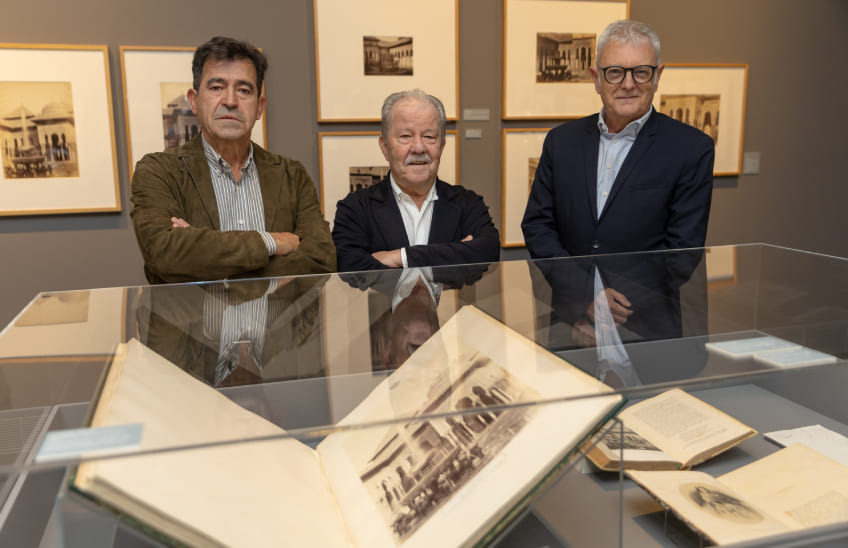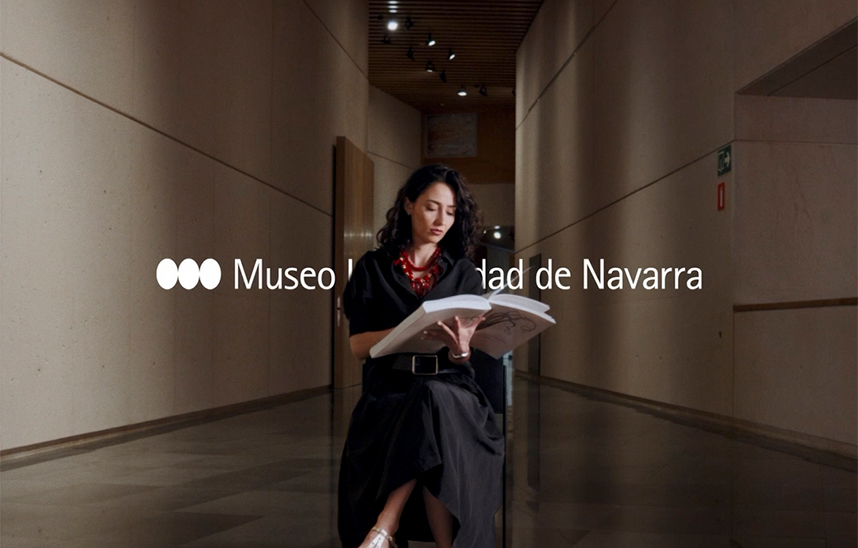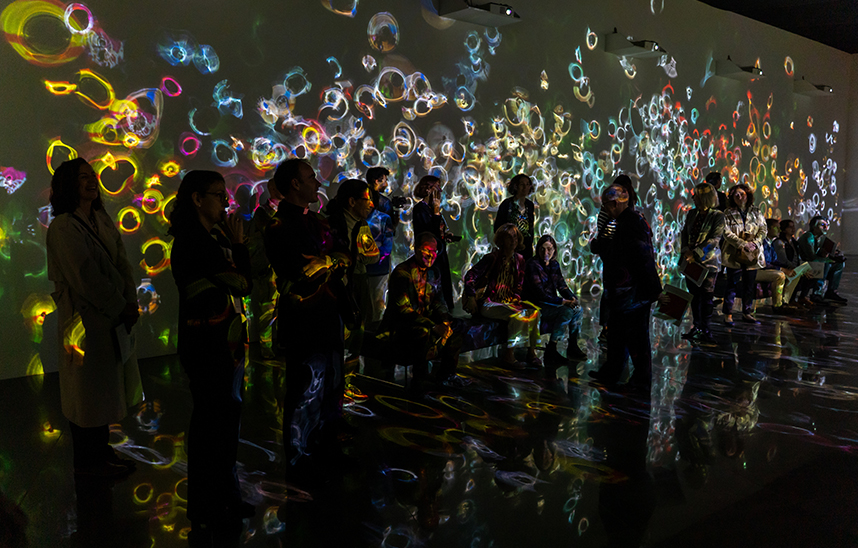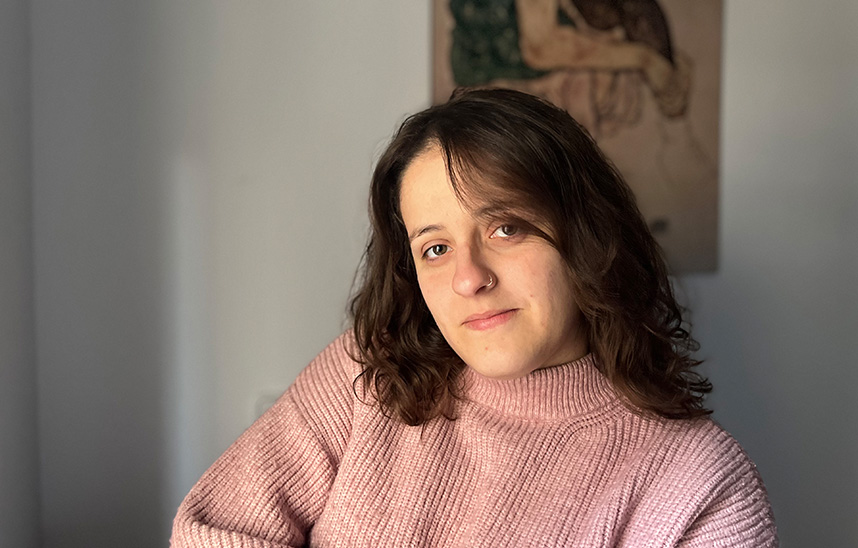Fear of the other, protagonist of Muntdas' new production at MUN
The author delves into the concept of fear, with a video installation on the journey of confinement as the centerpiece of the sample. It is the result of his participation in Tender Bridges, MUN's artistic residency program.

FotoManuelCastells/Artist Antoni Muntadas in front of the mural "The construction of fear".
15 | 10 | 2025
The MUN presents the new production by artist Antoni Muntadas, result from his participation in the Tender Bridges artistic residency program. The exhibition "Otros miedos" (Other Fears), on view until February 8, brings together his new audiovisual production, entitled "Entre miedos" (2022-2025), with a selection of previous works on the same topic: video works and graphic interventions that propose different approaches to different types of fears. Visitors will enter an immersive video installation that will allow them to "step on" the route of the Sanfermines running of the bulls and walk under the Pamplona sky, enveloped in sounds that complete the experience. I draw from sociological and anthropological experiences," says Muntadas. -Art for me is interdisciplinary.
Today, Wednesday October 15 at 7 p.m., there will be a masterclass with the artist and the curator -BartomeuMarí-, with free access by collecting an invitation on the website or at the locker. It will be followed by the inauguration of the space. Throughout 2025, the visit to the MUN is free on the occasion of its tenth anniversary and thanks to the partnership the City Council of Pamplona.
The "uses" of fear
The newly created audiovisual work presented by the sample ("Entre Miedos", 2022-2025) is based on a project that seeks to analyze how Western societies have come to use fear as one of the main political instruments since the beginning of the 21st century. Muntadas explores how it acts, what are its consequences, the uses that are made of it when individual fears become collective feelings. "I have been seeing this status since the attack on the Twin Towers in 2001; how politics has been appropriating this use of fear," he explains. This is approached, thus, as a series of emotions that influence the training of ideologies, replacing rational arguments or debates of ideas. "Fear involves very complex emotions," he points out, and highlights the fact that we experience it from childhood, through the fear of making decisions in adolescence, among other moments of life.
The Sanfermines are the setting for this exploration by the Catalan artist. "I wanted to revisit them and see that this relationship between the runner and the bull" produces a fear linked "with the fear of the other," he shares. "I wanted to dissect it and make it emotional and staff, beyond the epic spread by Hemingway," in what he defines as "a very specific status emotionally." "Entre miedos" extracts visual and auditory elements of the festivity, and is structured in two projections: on the one hand, the floors of the streets traveled in the running of the bulls projected on the ground; and on the other, on the ceiling, the sky that covers the route, in which the crests of some buildings can be guessed.
These images were recorded, moreover, at a very particular moment: Covid 19 and the confinement. "We all closed and, here, in the silence, the Sanfermines were 'closed'," contextualizes Valentín Vallhonrat, collection advisor of the MUN. Muntadas saw it as an opportunity to develop this project linked to Navarre, to Pamplona, to the Museum," he says, and so he came to record the running of the bulls when no one was there: "The noise made by the silence in Pamplona when the Sanfermines were cancelled was deafening," Vallhonrat recalls. The absence of the running, the screams and, above all, the sound of a pulse that was fear", for a moment of uncertainty, of people falling ill or dying... And Muntadas documented this context "from an artistic language".
But the viewer can also listen to sounds recorded during the running of the bulls, interspersed with comments from people who participated in the degree program. "When the pandemic ended and the Sanfermines were recovered, Muntadas returned to record the sound that was missing from that 'thunderous silence', that empty image," explains Vallhonrat. These sounds are of core topic importance, since, as the artist himself emphasizes, "we could almost follow the running of the bulls with our eyes closed".
On how to approach this installation, the author compares it to the way of being in an electronic music concert, in which the visitor can wander, "make it his own, find his place through the perception of each one". As Bartomeu Marí, the samples curator, sums it up, it is "a thrilling work".
On the other hand, the rest of the pieces included in the exhibition "Other Fears" provide visitors with a context for the reception and understanding of the new work, with a multidisciplinary perspective, as the curator points out: "Muntadas makes use of new means for artistic production, connected with the realities of the development of Western culture". Thus, the sample is completed with the television intervention projects "On Translation: Fear/Miedo" (2005), about the border between Mexico and the United States, and "On Translation: Miedo/Jauf" (2007), about the Strait of Gibraltar. It includes "Alphaville e outros" (2011), a video based in Alphaville, a "walled" residential neighborhood in São Paulo, Brazil, which speaks of exclusion resulting from fear in the search for security and well-being. "The Construction of Fear" (2008 - 2025) displays on a mural headlines that appeared in the months prior to the inauguration in the local and national press, including the word "fear" and synonyms. While "Fear, Panic, Terror" (2011) refers to how the publishing house industry has made fear a literary genre of great popular success.
This brings to 63 the number of exhibitions that the MUN has programmed in its first ten years of life, during which time 55 artistic residencies have taken place: 15 in the performing arts and music, and 40 in the visual arts. A large part of the latter correspond to the Tender Bridges program, in which artists generate new projects in dialogue with the MUN Collection, which contains 25,000 works of art (photography, painting, sculpture, video, installations...). In this way, the Museo Universidad de Navarra positions itself as a center for artistic creation and knowledge generation.
Vallhonrat also underlines the university character of the MUN as "part of its DNA". In fact, Muntadas has held a meeting with students of the Master's Degree in curatorial programs of study the Museum, to share with them his trajectory and "open their artistic processes so that they can be transited".




